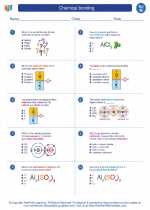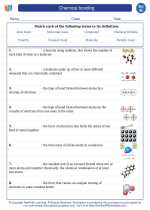Chemical bonding -> covalent bonds
Covalent Bonds
A covalent bond is a type of chemical bond that involves the sharing of electron pairs between atoms. These bonds occur when atoms share electrons in order to achieve a full outer shell of electrons, resulting in a stable configuration. Covalent bonds are typically formed between non-metal atoms.
Formation of Covalent Bonds
Covalent bonds are formed through the sharing of electrons. When two atoms come close together, their electron clouds overlap, and the electrons are shared between the atoms. Each atom contributes one or more electrons to the shared pair, allowing both atoms to achieve a more stable electron configuration.
Characteristics of Covalent Bonds
- Covalent bonds are typically formed between non-metal atoms.
- They involve the sharing of electron pairs between atoms.
- Covalent bonds are strong, but not as strong as ionic bonds.
- Covalent compounds tend to have lower melting and boiling points compared to ionic compounds.
- Covalent compounds can exist as solids, liquids, or gases at room temperature.
Polarity of Covalent Bonds
Covalent bonds can be either polar or nonpolar, depending on the electronegativity difference between the atoms involved. If the atoms have similar electronegativities, the bond is nonpolar, meaning the electrons are shared equally. If there is a significant electronegativity difference, the bond is polar, with the more electronegative atom attracting the shared electrons more strongly.
Study Guide for Covalent Bonds
- What is a covalent bond and how is it formed?
- Compare and contrast covalent bonds with ionic bonds.
- Explain the concept of polarity in covalent bonds.
- Give examples of covalent compounds and their properties.
- Discuss the role of electronegativity in determining bond polarity.
For further practice, you can also review Lewis dot structures and molecular geometry, as these concepts are closely related to covalent bonding.
.◂Science Worksheets and Study Guides Eighth Grade. Chemical bonding

 Worksheet/Answer key
Worksheet/Answer key
 Worksheet/Answer key
Worksheet/Answer key
 Worksheet/Answer key
Worksheet/Answer key
 Vocabulary/Answer key
Vocabulary/Answer key
